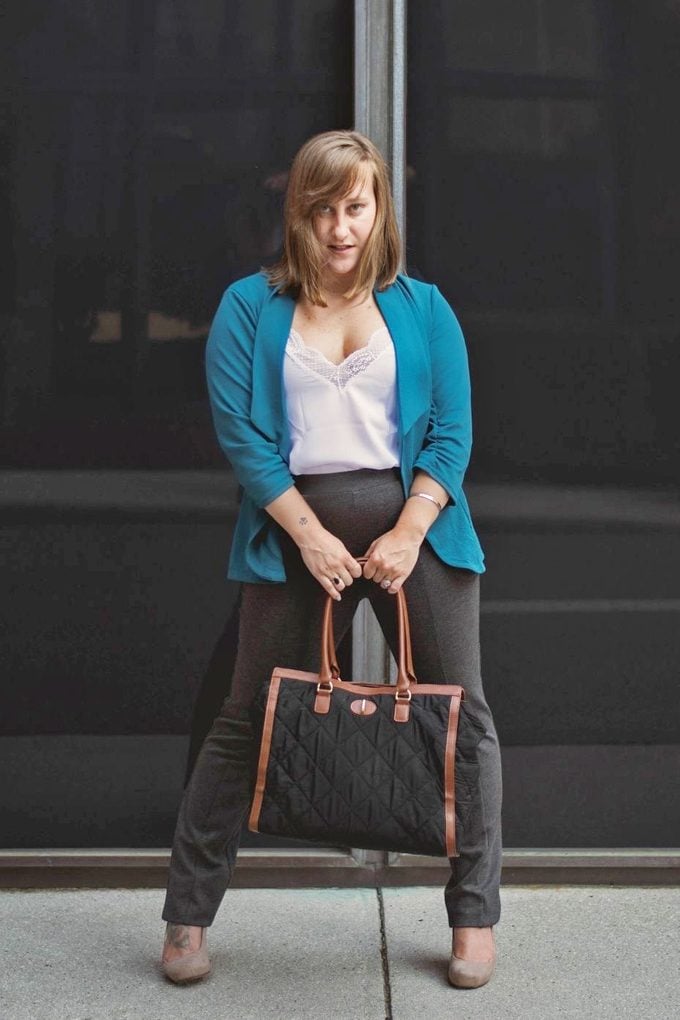These 6 Budget Cuts Helped Me Pay Off $71,000 in Debt
Updated: Jun. 30, 2022
This 29-year-old woman went from broke and in debt to owner of a thriving business, and it all started with six simple budget cuts.

More than 12 million Americans are victims of domestic abuse each year, and while the effects of that trauma are often primarily emotional, domestic abuse also takes a financial toll. Vee Weir is numbered among these victims, but thankfully, her story has a happy ending. She broke free from an abusive relationship and went on to thrive, founding the popular personal finance site Vee Frugal Fox in the process. Taking control of her finances was an essential part of her success.
Finding the courage to make a change
Five years ago, Weir’s life looked a lot different than it does now. On the surface, her marriage appeared ideal. She and her (now ex) husband lived in a charming beach house in Wilmington, NC—she worked in marketing and he was a detention officer with the local sheriff’s office. But if you looked a little closer, you would find an exhausted woman who was struggling to survive physical, mental, and financial abuse.
Weir’s ex made three times as much money as she did, and he used that financial power to his advantage—blocking her access to joint accounts as he saw fit. It wasn’t until the day she didn’t have enough money to cover the anti-depressants she needed to function that Weir experienced her “aha” moment. She knew something had to change, and after discovering her abuser was also cheating on her, she found the strength to leave the toxic relationship.
New beginnings
Leaving her abusive marriage had a big financial impact on Weir. While married, her ex paid the monthly bills and Weir used her income to pay off $50,000 in debt (much of which her ex had accumulated). But at the time of separation, she had less than $1,000 to her name, and that was only because she had forgotten to add her ex to her bank account. Broke and feeling broken, she got a storage facility for her belongings and moved back into her old childhood bedroom, where she stayed for a few months.
Once she was a bit more financially stable, she moved into a reduced-rent room where her cousin was the landlord. “If it hadn’t been for my large support network,” Weir says, “I wouldn’t have been able to survive.” Newly single and going through a divorce, Weir led a financially responsible lifestyle. She continued with the small spending cuts she had started before separating from her ex. But she was able to fully commit to the process now that she no longer had a partner with different financial goals fighting against her.
Budget cut #1: Cable TV
The first spending cut Weir made was cutting the cord—the cable TV cord, that is. “Cable is extremely expensive,” says Weir, “and as more and more subscription apps become available, entertainment as a whole can quickly become a money pit. That’s why I cut cable and allowed myself one or two [streaming] apps.” She went from spending around $250 per month to just $12. (Eventually, she increased that number to $20.) This small financial change added almost $240 per month back into her budget. (Psst! These 8 cable TV alternatives can make it easier for you to adopt this money-saving technique in your own life.)
Budget cut #2: New clothing and accessories
Another way Weir saved money was by avoiding the cost of new clothing and accessories. “Outside of uniforms and work clothing,” Weir says, “I stopped buying [clothes] or bought clothing second-hand.” With the average American family spending around $134 per month on clothing, this change made a meaningful difference in her financial bottom line. It’s also worth noting that many shopping trips are a coping mechanism that try to cover other emotions. If you struggle with emotional shopping or impulse purchases, these 23 psychology tricks could help you spend less money.
Budget cut #3: Going…anywhere
Weir eventually relocated to Colorado, where she currently lives with her new husband, Joe. And while the couple loves all the natural beauty their state has to offer, for a while they spent much of their time at home to save money. “If we went anywhere, it was five hours away, max. And we always came home,” says Weir. She does not believe that you can’t go on vacation during your debt-free journey.
However, she recommends making a budget and controlling your spending to make travel as affordable as possible while you’re trying to eliminate debt: “We wanted to pay down our debt faster, so we opted to spend a year in our home and put any money that would have been spent on vacations toward debt.” With the average vacation costing $1,145 per person, that decision led to a savings of around $190 per month for the couple. Check out these affordable mini vacations for inspiration.
Budget cut #4: Car payments
A vehicle is an essential tool for most American households. Weir’s own vehicle, a 2004 Saturn Ion, was in rough shape when she started working to save money and pay off debt. “I wanted to get a new car,” says Weir, “but I knew that would mean an extra car payment on top of what I was already paying off.” So, she made the choice to continue driving the vehicle for as long as she could to keep her monthly bills as low as possible. With the average monthly payment on a new vehicle hovering around $560 per month, according to Lendingtree, this decision added greatly to Weir’s monthly savings tally.
Budget cut #5: Eating out
Dining out can be expensive. It’s a big budget downfall for many households. Understanding this fact, Weir made some major cuts to her budget when it came to eating out. “I’m not suggesting you don’t see the inside of a restaurant while you’re paying off debt. That’s unrealistic,” says Weir. “I am saying that we reduced our dining-out budget to one or two meals per month.” The couple put some cash aside for special date nights. Meanwhile, the rest of what they would normally spend on restaurants (around $465 per month based on the average household budget) didn’t go into their stomachs—it went toward paying down debt instead. Here’s how another woman saved $400 per month on groceries.
Budget cut #6: Reducing necessary premiums
There are certain bills you have to pay each month, like auto insurance and cell phone service. But that doesn’t mean there isn’t room for savings. Weir and her husband shopped around for reduced-cost cell phone plans and more affordable insurance premiums, and the budget cuts added up. “You may think that these things don’t have a huge impact on your budget,” says Weir, “but they do!”
Cutting a $200 cell phone bill in half can save you $100 per month. Lower a $75 monthly car insurance premium to $50 and you free up another $300 per year. “These bills aren’t fun, but you need these services. You may as well try to get the lowest price you can for them,” Weir says. These 60+ ideas on how to lower your household bills can help you find some savings potential of your own.
How she made the most of her savings
Budget cuts aren’t always fun at the time, but Weir’s sacrifices paid off in big ways. She has been able to funnel the money she saved toward more important goals, like paying off debt and starting her own business. “With my savings, I was able to open my business, Weir Digital Marketing, which has been a dream come true,” Weir says. “Now I get to help other creators in the personal finance space educate people who were in my situation.” Over the course of five years, she paid off an impressive total of $71,000 in debt.
The takeaway
Weir is passionate about teaching others—especially women—about how to take control of their financial lives. “As women, we need to make financial literacy accessible and a priority in our lives, even if our partners ‘take care of it,'” says Weir. “This isn’t an option but a requirement in today’s world. If I hadn’t known anything about money, I would have been in a very dark place. Protect yourself and protect your assets.” Here’s another story of a young couple that paid off five figures’ worth of debt in under two years.
Sources:
- Reader’s Digest, 16 Unavoidable Facts About Domestic Violence
- Lendingtree, Average Car Payment Loan Statistics 2021
- MVOrganizing, How much does the average American family spend on clothing per month?
- CreditDonkey, Study: Average Cost of a Vacation
- The Simple Dollar, Don’t Eat Out as Often



